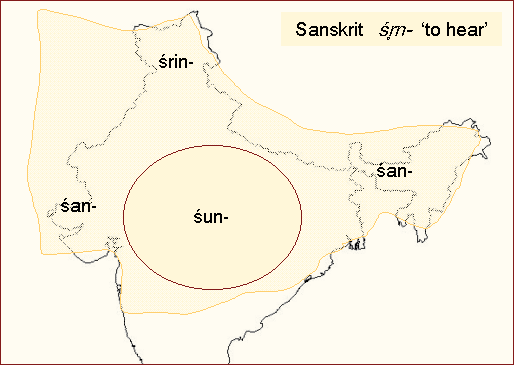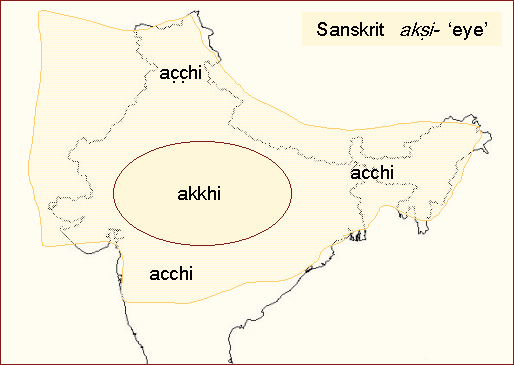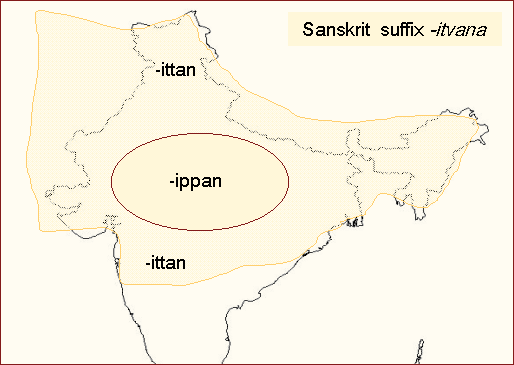History of the Romani language
Proto-Romani
Proto-Romani is believed to have emerged not in the Northwest of India, as is sometimes reported in popular literature (and as was indeed suggested by some nineteenth-century scholars), but in Central India (see already Turner 1926). It shares a number of early developments that are confined to the forerunners of the Central Indian languages, such as šun-'to hear' from Old Indic (Sanskrit) śr̥n- (see Map 2), jakh 'eye' (via *akkhi) from Old Indic akṣi- (Map 3), or the phonological shape of the nominalising suffix -ipen (as in sastipen 'health'), from Old Indic -itvana (Map 4). This combination of features emerged during the early transition stage from Old to Middle Indic, sometime after 500 BCE, and proves that Proto-Romani began its history as a Central Indian language.
Some Old Indic features are retained in Romani, even though they were changed in the group of Central Indian languages. For example, Romani retains the consonant combinations tr and št in words like patrin 'leaf' (from Old Indic patra-) and mišto 'good' (from Old Indic mr̥ṣṭaḥ). These were simplified in the Central languages during the transition to the Middle Indic period, giving patta and miṭṭha respectively (Map 5). It appears therefore that speakers of Proto-Romani left the Central Indian region at some point during the first half of the first millennium CE, before the clusters were simplified, and migrated to the northwest, an area that remained unaffected by these changes; this suggestion too was first made by Turner in 1926.
Proto-Romani continued, however, to participate in structural changes that affected the bulk of Indic languages throughout the subcontinent, leading into the early New Indic period. These included the simplification of other sound combinations like rp and pt, for example in sap 'snake', via Middle Indic sappa, from Old Indic sarpa, and tato 'hot', via Middle Indic tatta, from Old Indic tapta. They also included grammatical developments, such as the loss of the elaborate Old and Middle Indic nominal case endings and their reduction to a simple opposition between Nominative and Oblique, as in Romani rakl-o 'boy.NOM', rakl-es- 'boy.OBL' (compare Hindi laṛk-ā 'boy.NOM', laṛk-e- 'boy.OBL'), or the disappearance of the Old and Middle Indic past-tense conjugation and the generalisation of the past participle instead, still visible in some dialects of Romani, as in ov gelo 'he went', oj geli 'she went' (compare Hindi vo gayā 'he went', vo gayī 'she went'). It is clear, then, that Proto-Romani continued to be part of the subcontinental Indic language environment during the transition period to early New Indic, which took place in medieval times, perhaps around the eighth or ninth century CE.
There are several structural features that Romani shares specifically with the languages of the Northwest, the so-called 'Dardic' languages of India (such as Kashmiri). They include, first, the retention of consonant clusters such as tr and št, which were mentioned above. Other shared conservative features include the retention of consonantal endings such as -s and -n in oblique case endings, and the retention of -n- in words like dand 'tooth' (from Old Indic danta; cf. by contrast Hindi dẫt). But Romani also shares an important innovation with the Dardic languages: The emergence of a new past-tense conjugation, based on the attachment of enclitic pronouns to the participle. The Romani past-tense conjugation forms kerdjom 'I did', kerdjas 'he/she did' and so on emerged from combinations like *kerdo-jo-me 'done-by-me', *kerdo-jo-se 'done by him/her'. This development offers further evidence that Proto-Romani was spoken in the extreme northwestern areas of the Indian subcontinent in medieval times.





